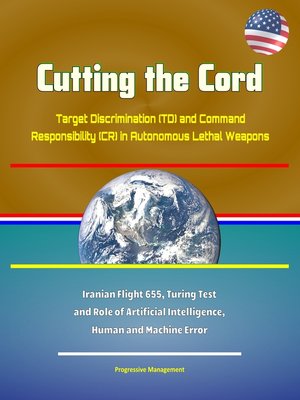Cutting the Cord
ebook ∣ Target Discrimination (TD) and Command Responsibility (CR) in Autonomous Lethal Weapons--Iranian Flight 655, Turing Test and Role of Artificial Intelligence, Human and Machine Error

Sign up to save your library
With an OverDrive account, you can save your favorite libraries for at-a-glance information about availability. Find out more about OverDrive accounts.
Find this title in Libby, the library reading app by OverDrive.



Search for a digital library with this title
Title found at these libraries:
| Library Name | Distance |
|---|---|
| Loading... |
This report has been professionally converted for accurate flowing-text e-book format reproduction. The focus of this research is to examine the relationship between target discrimination (TD) and command responsibility (CR) as the primary barrier to the lawful use of autonomous lethal weapons under jus in hello. This paper begins with a thesis followed by three main points regarding the relationship and dependencies between TD and CR in the context of autonomous lethal weapons. Discrete roles in air-to-air and Air Interdiction are described that may permit autonomous systems to meet or exceed human thresholds in target discrimination and commensurate risk, followed by two brief case studies in fratricide to illustrate the main points submitted. Ultimately this research concludes that there is clear potential for autonomous lethal weapons to follow objective legal decision trees to meet rules of engagement criteria for the application of lethal force.
This compilation includes a reproduction of the 2019 Worldwide Threat Assessment of the U.S. Intelligence Community.
Current force guidance documents indicate the US military intends to substantially increase its unmanned assets, seek mechanisms to reduce manning and spending under growing fiscal constraints, and counter anti-access/denial strategies employed by potential adversaries in order to maintain an advantage in armed conflict. The confluence of these goals makes remotely piloted aircraft (RPA) an attractive solution to cost-effective combat, simultaneously reducing the deployed footprint of forces, permitting extended duration sorties that translate into increased range or dwell time, and lowering the risk to (pilot) combatants. As an extension of remote employment, autonomous unmanned air vehicles (UAV) would further reduce the number of human combatants, deny vulnerabilities in RPA command and control (C2) architecture, increase economies of scale through cooperative swarms, reduce the psychological stresses affecting RPA pilots by their displacement, and increase the speed of engagements. A further advantage of autonomous weapons is their strict adherence to (literal) codes of conduct. Autonomous lethal weapons (ALW) challenge standing moral and legal conventions, however, and their ultimate utility must rest upon the assurance that their employment will be possible within these bounds, or the conventions themselves (or accepted interpretation of them) must be challenged. Jus in hello is the subset of just war theory focused on just conduct in war. It is the evolving product of global norms, cultures, and technology, which are reflected and codified in customary, national and international law, as well as conventions proper, such as Hague and Geneva. The focus of this paper is to examine the relationship between target discrimination (TD) and command responsibility (CR) as the primary barrier to the lawful use of autonomous lethal weapons under jus in hello.







